-
TrackoBit
Manage commercial vehicles with the new-age Fleet Management Software
TrackoBit -
TrackoField
Streamline your scattered workforce with Field Force Management Software
TrackoField -
Features Resources
-
Blog
Carefully curated articles to update you on industrial trends. -
White Paper
Insightful papers and analysis on essential subject matters. -
Glossary
Explore an alphabetical list of relevant industry terms. -
What’s New
Get TrackoBit & TrackoField monthly updates here. -
Case Study
Explore the cases we solved with our diverse solutions. -
Comparisons
Compare platforms, features, and pricing to find your best fit.
-
About Us
Get to know TrackoBit: our team, ethos, values, and vision. -
Careers
Join the most dynamic cult of coders, creatives and changemakers. -
Tech Support
Learn about our technical support team and services in detail. -
Events
Check out the exhibitions where we left our marks and conquered. -
Contact Us
Connect with us and let us know how we can be of service.
How to Track Remote Workers with Employee Monitoring Software? Guide 2026
- Author:Shivani Singh
- Read Time:6 min
- Published:
- Last Update: January 7, 2026
Table of Contents
Toggle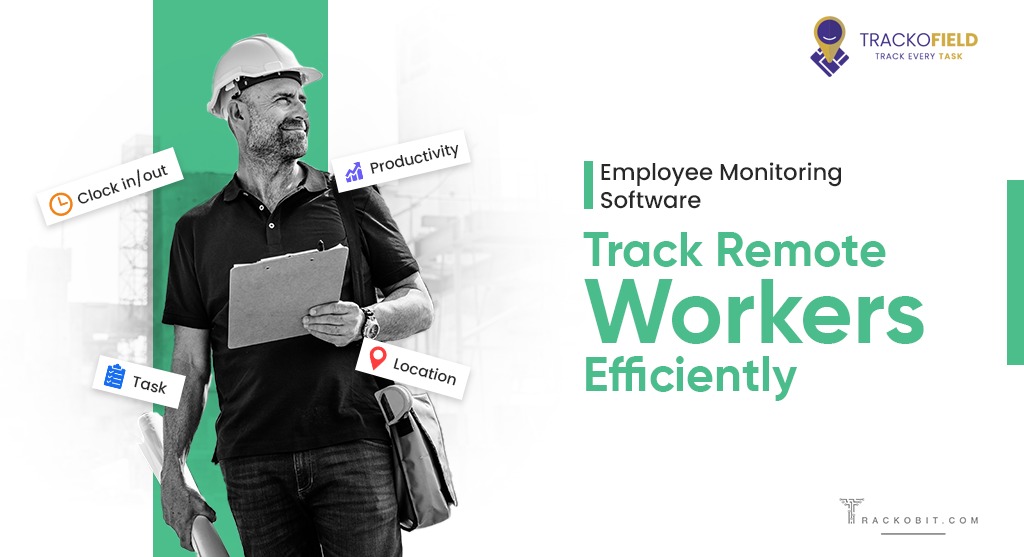
Track every single activity of your remote employees and demystify the mystery around how they utilize their working hours with an employee monitoring software solution.
Table of Contents
Toggle
Adequate visibility into remote employees’ performance is necessary.
Especially, in this new work terrain where employee productivity is directly proportional to an organization’s success and growth. Moreover, without knowing your workforce’s actual productivity levels, you may lose the ability to make insightful decisions.
But, these hurdles will move away when you have the best employee monitoring software in your quiver. It enables you to keep the project on track by ensuring the right use of working hours and other resources. Consequently, its unified abilities lead to clear peer-to-peer communication, improved transparency, and 360-degree visibility over business operations.
To learn more about remote employee monitoring software and its practical benefits, keep scrolling and reading further.
An Insight into Employee Monitoring Software
Employee monitoring software helps managers monitor their remote workforce. The software provides real-time insight into employees’ whereabouts, task status, distance traveled, expenses incurred, and productivity. With this insight, managers can better analyze their employees’ performance and, thus, monitor real-time productivity.
Here are some practical ways you can leverage employee monitoring software:
- To stay ahead of operational activities
- To control your employees’ tasks, locations, and expenses
- To delegate remote tasks
- To assess the distance traveled by employees while on duty
- To track employees’ total working hours
- To detect trends and patterns for further decision-making
Check out the table below to learn more about employee monitoring software, and what modules and offerings it covers. You will also get insight into the outcomes of resorting to the software.
Read Blog – Future of Employee Monitoring Software In 2026
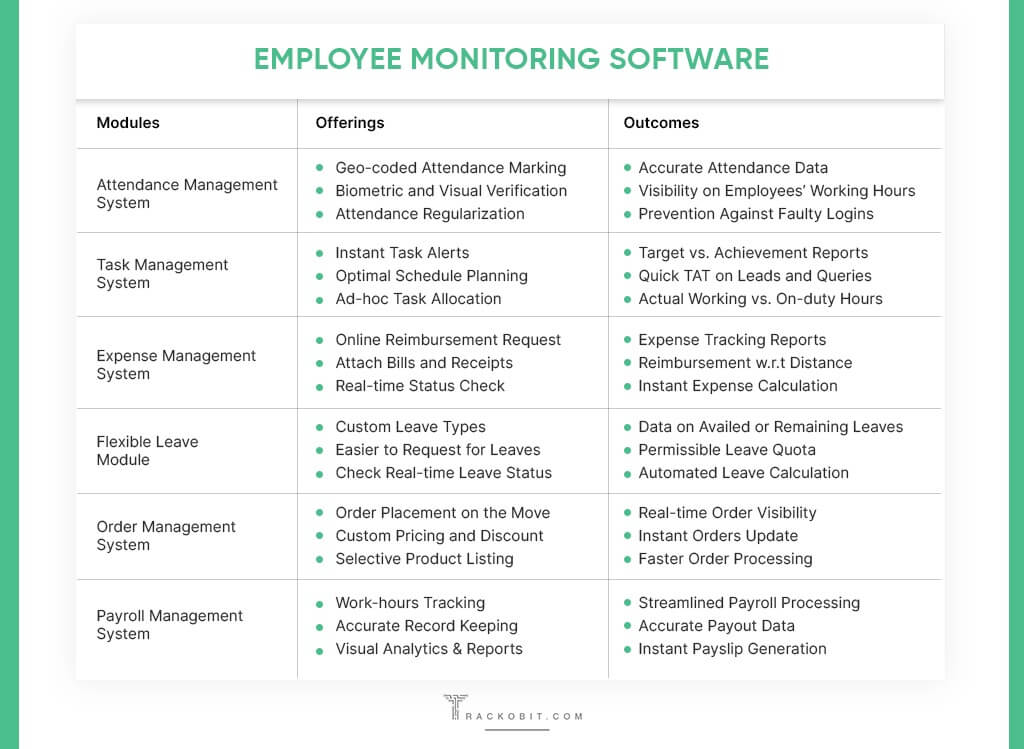
How Employee Monitoring Software Helps in Tracking Remote Workers?
In remote jobs, employees complete their work outside the typical office environment. An example of this could be field employees who move to multiple sites to complete their work orders. They rely on video calls, phone calls, and messaging apps to communicate with other team members or managers. However, this leads to operational gaps and time leakage along the process. It also adds to managers’ burden and keeps them from locating quality data.
That’s why…
Almost 60% of companies systematically analyze remote employees’ activities, time-offs, performance, and productivity with employee monitoring software.
Here is how the software helps in tracking remote workers:
1. Geo-coded attendance – To track employees’ locations and punch-in/out time
Remote employees may mark their attendance remotely, from anywhere. The geo-coded attendance enabled software records the exact location and time of the punching. This prevents them from commuting daily to the office to record their clock-in.
Managers assess the time stamps and geo-coordinates from where employees mark their attendance. It helps them validate that employees are present where they should be.
Moreover, the software allows managers to enable location-based and time-based mark-ins/outs. Employees can not log in from anywhere other than the specified location or the location of the first task of the day.
2. Target vs. Achievement reports – To assess the achievement against the target allocated
Managers can view the target vs achievement report of any specific user, team, or the entire field staff to monitor their productivity with a single click. Moreover, this feature helps managers.
- Creating employee-specific targets
- Conducting real-time performance evaluations
- Identifying flaws in the strategy or workflow
They can take corrective measures by identifying the cause behind uncompleted goals and targets. If necessary, managers can also conduct training programs for their underutilized employees.
3. Distance traveled reports – To discover the miles covered by employees during their working hours
Distance traveled reports record employees’ locations, distance traveled, stoppages, etc. from the moment they mark their attendance.
Managers with just a glance at these reports get complete visibility into employees’ movements. They also evaluate reimbursement w.r.t. distance. This prevents employees from adding extra distance to their productivity for the sake of increased payments. Thus, facilitating better expense management and accurate payments to employees.
4. Time tracking tool – To evaluate how much time employees spend on fields.
The tool starts tracking employees’ time after they successfully log in to take tasks for the day. It eradicates the need for them to manually fill their timesheets. Thus, saving their time and effort for organizational activities.
By using the tool, managers can easily track how many hours employees utilized for certain tasks, be it from home, office, or field site. Moreover, it helps in spotting patterns of unnecessary halts, breaks, or idling.
5. Alerts & Notifications – To keep everyone in the loop
Not only does the employee monitoring software provide in-built chat support for team members but also ensures alerts & notifications when there is an ad-hoc task requirement, meeting, deadline, or change in shift.
The employee monitoring software sends reminders for ad-hoc tasks, meetings, deadlines, or shift changes.
Meanwhile, managers receive alerts & notifications when an employee exits the task’s location, takes extended breaks, updates their task status, requests a day off, etc.
6. Real-time status – To keep a check on every process
Remote employee monitoring software solutions coupled with GPS technology help fetch employees’ real-time movements, task status, and other activities.
This lets managers enjoy live employee tracking and workforce monitoring. They can simply manage 100s and 1000s of staff working remotely from a single platform.
7. Optimal schedule planning – To work most efficiently and effectively
With pre-planned schedules, employees stay on track and know accurately what they are supposed to do in the upcoming days. They get quick access to their jobs and wrap them up without delays.
Optimal scheduling helps managers handle workforce gaps, unforeseen absenteeism, or unpredictable workloads. It also ensures that ongoing tasks are completed on time without unnecessary stress or hiring more staff for that period.
8. Automated leave management system – To store employees’ days-off on the cloud
Right from their employee monitoring apps, employees select the day, duration, and date on which they need leave and submit the same. Just after this, their leave balance gets automatically updated.
Managers analyze this leave data to learn absenteeism trends, i.e., on which month or day employees take the most leaves. Thus, they plan better to ensure that an employee’s absence will not disturb the existing workflow.
9. Insightful dashboard – To identify and analyze overall business productivity.
Employee monitoring software also provides a data-driven dashboard. Looking at this, managers can simply acknowledge the shortcomings in their business operations. Thus, deriving better strategies to make the most out of those challenges.
Monitoring vs. Spying in Remote Workplace
Various field service management-based businesses confuse the term monitoring with spying. However, they are different in a lot more ways. While legitimate employee monitoring focuses on evaluating productivity, identifying areas for improvement, and optimizing workflows, Spying involves secretly gathering information on employees without a clear business motive.
Take a look at the creative below to better understand the difference between employee monitoring vs. spying.
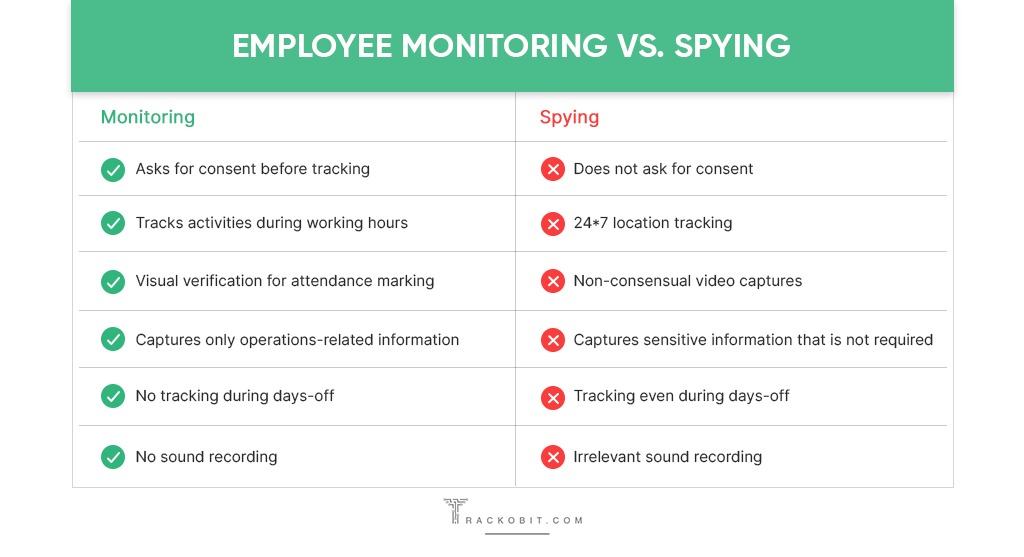
Employee monitoring considers employees’ consent before tracking their remote activities. Spying, however, does not seek permission and record employees’ sensitive information beyond their operational activities.
With employee monitoring, businesses aim to accomplish:
- Streamlined Workflow
- Better Team Coordination
- Employee Recognition
- Informed Decision Making
- Enhanced Data Security
- Prevention Against Time Theft
However, businesses with spying only get
- Diminished Morale
- Sensitive Data Exposure
- Agitated Workforce
- Potential Trust Issues
Conclusion!
In this time and age, where organizations rely on automation, analytics, and AI to enhance their capabilities, it is unfathomable for a business to overlook the power of data. And when it comes to field employee tracking, a legitimate software solution powered with the latest technology is your go-to option.
So, switch to an automation-enabled employee monitoring software like TrackoField.
The software, while respecting employees’ boundaries, tracks their every movement on the field. Also, it comes with robust functionalities that make not just tracking but ad-hoc task allocation, shift scheduling, expense management, attendance marking, and leave approval a breeze.
Looking for further insights?
What about reaching out to our experts for a demo or signing up for a free trial to get started right away? We are more than happy to revolutionize your workforce with employee monitoring software.
Frequently Asked Questions
-
What are the ways of monitoring remote employees?
Monitoring remote workers is not that hard. You just have to switch to employee monitoring software like TrackoField and from there you can easily track: - Your employees’ attendance - Their time spent on completing a task - Distance traveled by them - Expenses incurred during their journey to the client’s site - Time offs and breaks while they are on duty.
-
How do employers track remote workers?
There are lots of ways that employers adopt to track their remote workers like calling back and forth, manual attendance marking, and task allocation on multiple apps. However, these are not appropriate as they may create the scope for manual errors and duplicate entries. In replace of those, employers must use employee monitoring software for accurate remote employee productivity monitoring. The software offers various tools that make employee tracking and monitoring a cakewalk.
Shivani is a Content Specialist working for TrackoField. She comes with years of experience writing, editing and reviewing content for software products. Her underlining expertise in SaaS especially H... Read More
Related Blogs
-

Grameen Credit Score: Everything that NBFCs and MFIs Must Know in 2026
Shemanti Ghosh January 6, 2026Empower the underserved Joint Liability Groups (JLG), Self-Help Groups (SHG), and residents of rural India with better credit assessment and…
-
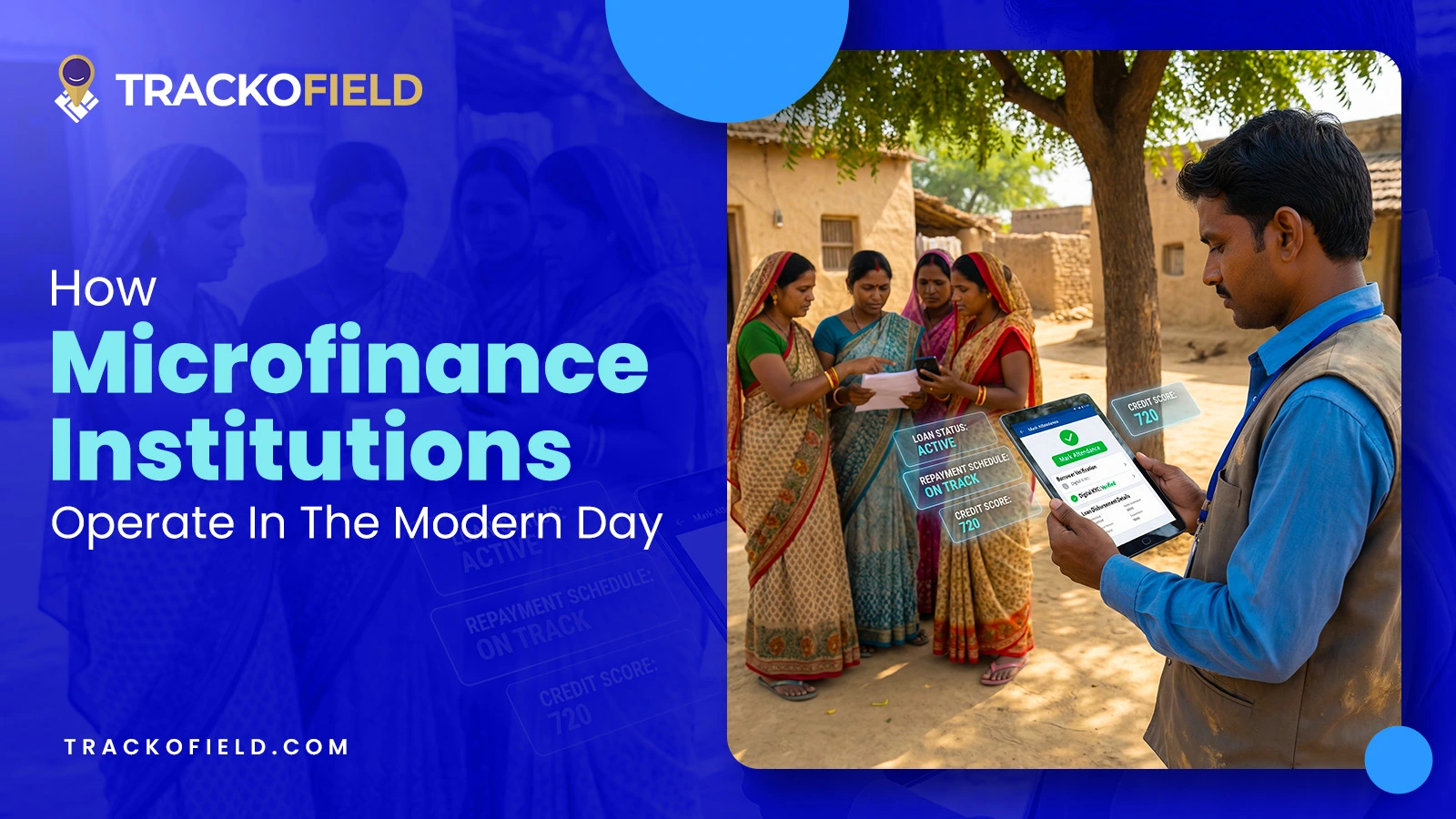
How MFIs Are Working In Modern Day Scenario? A Complete Breakdown
Mudit Chhikara December 30, 2025How field force automation is helping MFIs transform field operations.
-
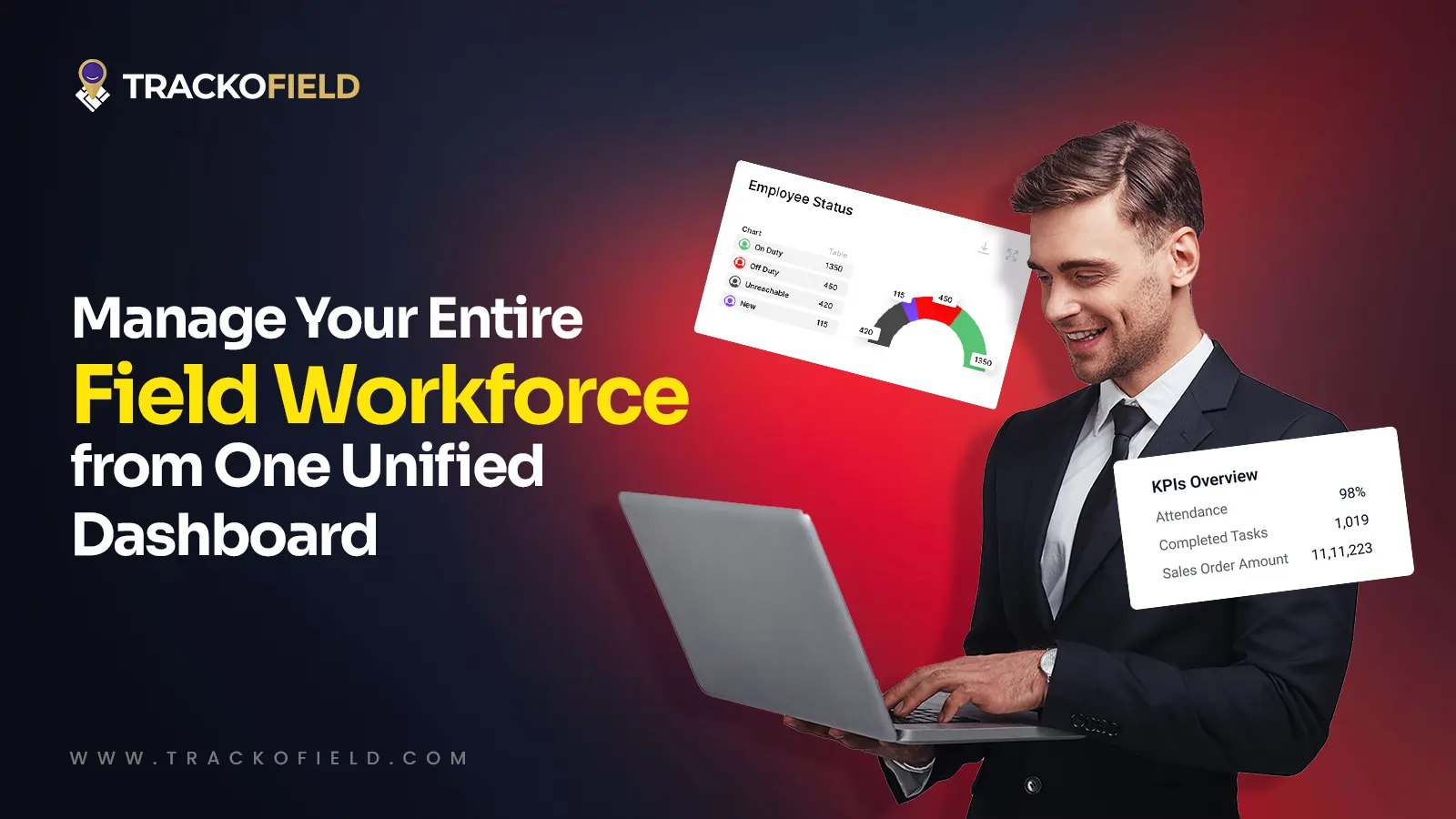
Unified Field Workforce Dashboard: Monitor Tasks, Attendance & More In One Place
Mudit Chhikara December 15, 2025Bring full clarity to field operations with a single, real-time field workforce dashboard.
-

Loan Disbursement in NBFCs: From 15 Days to 3 Minutes – Learn How
Shemanti Ghosh December 11, 2025TrackoField’s AI-enabled field force automation software speeds up loan disbursals in NBFC with field agent task monitoring and facial attendance…

Subscribe for weekly strategies to boost field team productivity.
Your inbox awaits a welcome email. Stay tuned for the latest blog updates & expert insights.
"While you're here, dive into some more reads or grab quick bites from our social platforms!"Stay Updated on tech, telematics and mobility. Don't miss out on the latest in the industry.
We use cookies to enhance and personalize your browsing experience. By continuing to use our website, you agree to our Privacy Policy.


































